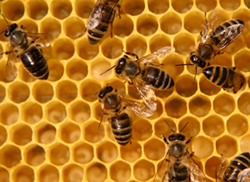I sometimes marvel at how we (myself included) routinely overlook some of the ways our God has revealed Himself through His magnificent creation. After all, as Romans 1:20 indicates, God’s awesome qualities are clearly revealed in all the works of His creation, so that no man can credibly deny His existence: “For since the creation of the world, His invisible attributes are clearly seen, being understood by the things that are made, even His eternal power and Godhead, so that they are without excuse.”
The evidence is overwhelming and can be witnessed everywhere. The “invisible God” is truly not hidden from us, but can be plainly “seen” throughout His created realm. Indeed, our God manifests His glory in an infinite number of ways—both large and small—throughout His creation
But God has chosen the foolish things of the world to put to shame the wise, and God has chosen the weak things of the world to put to shame the things which are mighty; and the base things of the world and the things which are despised God has chosen, and the things which are not, to bring to nothing the things that are, that no flesh should glory in His presence. 1 Corinthians 1:27–29 NKJV
Despised Things Bring Glory to God
I believe the above passage provides a key to how God often operates. He works in amazing and unexpected ways, as He has continually demonstrated throughout history. Even Jesus, the King of Kings Himself, came down to earth not as an earthly ruler with pomp and servants, but as a simple working man, who labored as a carpenter. He did not surround Himself with the prestigious, the popular, the wealthy or the learned, but chose mostly common, small town fisherman for His disciples and spent much of His time with the “undesirables” of His day.
So, should we really be surprised that the Lord’s glory might also be manifested in the weak and despicable things we often call “pests”—that we step on, swat away and literally try to “screen” out of our lives? As the saying goes, “God’s ways are not our ways.”
Truly, as we wander about in our day-to-day activities, all around us exists an amazing, overlooked world through which the Lord reveals His creative power and glory no less than any other part of His creation—the world of insects. And if we will take the time to consider some of these insignificant or “foolish things” of God’s creation, it will bring us to our knees!
We usually try to keep flies out of our houses and ants from visiting our food cabinets. And what about those disgusting cockroaches that carry disease? Do they magnify God’s glory? Yes, God’s majesty and creative power are indeed manifested in the little creatures we know as insects (or bugs), just as with the rest of His creation. In fact, with between 1 to 1.5 million species worldwide, insects comprise the most diverse and numerous group in the animal kingdom, representing over half the living things known to man. In North America (north of Mexico) alone, there are some 100,000 species of insects, bugs, spiders and their kin dwelling underfoot and ready to confound the “wise.” Yes, some can transmit disease, cause death and destroy billions of dollars worth of crops—not to mention ruin our picnics and scare us to death.
However, of all the varieties these creatures come in, only about 1% are the real culprits. The great majority of them are benign or have beneficial qualities. For example, while it might be a repugnant thought to most of us, many insects serve as an excellent source of food for people around the world. After all, they are lower in fat and higher in protein than most of the meats we eat. Insects help get rid of animal and plant wastes and predatory species, such as the praying mantis, ladybird beetle, dragonfly—and the much feared and despised spider—help keep the insect population in check by eating other insects. Most importantly, they occupy a significant place in the “food chain,” with many animals directly dependent on them for their nutrition, including us! Some, like honeybees, produce honey and/or pollinate plants, which provide much of the food (crops) and beauty (flowers) that we commonly take for granted.
Insects Challenge Evolution
Evolutionists like to showcase insects as examples of “evolution at work,” based on how well they have adapted to different environments.  However, adaptation is not evidence of evolutionary species-to-species change, but a tribute to the amazing and innate adaptive abilities God placed within them from the beginning. And when honestly investigated without evolutionary bias, many of these tiny creatures display amazingly complex behavioral characteristics to accomplish highly complicated tasks, requiring organization and social interactions that can only be explained by specific or special design.
However, adaptation is not evidence of evolutionary species-to-species change, but a tribute to the amazing and innate adaptive abilities God placed within them from the beginning. And when honestly investigated without evolutionary bias, many of these tiny creatures display amazingly complex behavioral characteristics to accomplish highly complicated tasks, requiring organization and social interactions that can only be explained by specific or special design.
Bees do their figure eight “dances” in the beehive to communicate a specific angle to the sun so other bees can find nectar. That is a truly complex task that evolution cannot explain. Another example is the highly ordered social networks that ants employ, including specific “job descriptions” required for the benefit of all and the successful operation of their colonies.
The evolutionary mechanisms of mutation and natural selection don’t begin to explain how these behaviors developed, whether gradually, over millions of years, suddenly, or in any other way. Instead, these creatures declare the glory of God by showing how perfectly designed they are for accomplishing their purposes, which could only result from the hands of an Intelligent Designer—an infinite, benevolent Creator.
Neither does evidence from the past provide support for the evolutionary development of these creatures. Looking at the fossil record, we find no shortage of modern-day insects throughout the evolutionary timeline. In an article titled, “Insect Evolution: A Major Problem for Evolution (Technical Journal of Creation [TJ 18(2) 2004]), Dr. Jerry Bergman states that over “100,000 specimens” have been found at one fossil site in Colorado, and that “over 150,000 fossil insects have been collected from Baltic amber alone.” These specimens, all supposedly millions of years old, look very similar—if not identical—to living insects. Cockroaches, ants, centipedes, beetles, spiders and many others found in amber, coal, volcanic ash, tar and other fossilized media, dated at millions of years old, have not changed. Bergman also states that “no consensus” exists among entomologists, regarding the evolutionary relationships of insects.
In fact, it is a tremendous challenge for evolutionists to explain how insects arose when they show no significant change over the supposed millions and millions of years. Because insects are found in the fossil record fully formed and, as with ants, termites and bees, fully equipped for their highly complex social behaviors, Darwinists try to dodge the lack of transitional forms by saying they evolved quickly. One popular evolutionary website states, “What seems most fascinating is that insects diversified in a brief 100 million years (give or take) into the modern forms that exist with minor change in modern times.”
Notice that it says “give or take” millions of years, because insects found very early in the evolutionary timetable show basically the same physical structures they have today. The only real change is in size. Many past insects were larger, as exemplified by dragonfly wingspans measured in feet and mayflies nearly 18 inches in width. This, of course, fits perfectly with the gigantism found in the fossil record for both plant and animal life, especially before Noah’s flood. Indeed, rather than providing proof for evolution, fossil insects confound evolutionists and this demonstrates their blind faith in evolution. So, why do we so easily ignore these creatures—which represent half the living world—and so clearly demonstrate the folly of evolution?
In addition to the evidence they provide for creation, insects display a truly remarkable array of different forms, behaviors and types of coloration. Some have “horns,” while others look like jewels—or sticks. Many posses an amazing ability to fly. They are endowed with an astounding assortment of legs to walk, crawl or jump, have the ability to make nocturnal sounds, eat with jaws like knives and, as we have discussed, some display harmonious and synchronized social patterns. It should be apparent to those who have “eyes to see and ears to hear” that these tiny creatures offer vivid testimony to a highly creative Being, and not to evolution. Maybe it’s time we stopped thinking of insects as “base and despised” and started to appreciate them as amazing creatures that reflect God’s glory in their own unique ways.
The Butterfly and the Gospel
Butterflies are an exception to the “detestable” world of insects and are extremely popular with our fellow humans. We like them so much, their images adorn our clothes, stained glass windows, decorative magnets…the list goes on and on. With their large, brightly colored, angel-like wings, often laced with intricate patterns, along with their gentle, feather-like flight, they represent beauty itself. Normally found near flowering plants in search of nectar, these delicate creatures can present an array of perpetually “bobbing” colors that dazzle our eyes. No wonder they are the most appreciated if not, indeed, “loved” insect of all the millions to choose from. They also offer unique testimony to God’s glory.
More than any other insect, butterflies typify the incredible physical changes that take place in the growth process God devised for all insects called metamorphosis. During this incredible process, utilizing the same DNA throughout, an insect actually goes through three or four different physical forms to become an adult that is responsible for the reproduction of its kind. “Complete metamorphosis” involves four basic stages: egg, larva, pupa and adult, while “incomplete metamorphosis” requires three stages, with usually the pupa stage skipped. The butterfly goes through complete metamorphosis, as do bees, flies, beetles and many other insects.
This process also challenges evolutionary claims of millions of years of slow change. After hatching into a caterpillar, which is the larval stage, the butterfly goes through a molting phase by anchoring itself in a hanging position and then turning itself into a stationary pupa or chrysalis. Inside, it basically turns itself into a liquid medium. This phase annually attracts millions of observers who marvel with anticipation, as they await the emergence of a beautiful adult butterfly. This transformative procedure, designed (for the most part) to destroy the old tissue and use the basic elements to build a new organism, confounds any evolutionary explanation. After all, how could such intermediate steps develop (or evolve) gradually over time? They couldn’t! They all had to be in place from the beginning or the insect couldn’t have survived. Such a mysterious and “magical” makeover is a powerful testimony to the infinite wisdom of our Creator, who designed and “hardwired” these creatures for such transformation from the start.
Of course, butterfly metamorphosis also symbolizes God’s desire and power to transform our lives. When Jesus addressed Nicodemus, the Pharisee, in John 3.3, He said, “Most assuredly, I say to you, unless one is born again, he cannot see the kingdom of God.” Much like butterfly metamorphosis, in order to fulfill God’s ultimate purpose for our lives, we need to undergo a complete change—in our case, from physical to spiritual beings. When the butterfly reaches its final stage, the same creature with the same DNA, somehow emerges with brand new features. Rather than crawling, it flies; rather than eating plants, it feeds on nectar or pollen; rather than using tiny eyelets to see, it now has compound eyes. All of these changes point to the power of God to renew our lives for His almighty glory. Just as the creeping caterpillar is transformed into a butterfly with the ability to fly, we also can be changed to soar like an eagle in our Creator’s magnificent plan. Therefore, if anyone is in Christ, he is a new creation; old things have passed away; behold things have become new, (2 Corinthians 5:17).
Metamorphosis: The Beauty and Design of Butterflies DVD
This month, our ministry is delighted to offer a new resource with spectacular photography, wonderful animation and expert testimony that features God’s beautiful creation, the butterfly. Through stunning, close-up photography, you will see inside a chrysalis and witness the amazing process of metamorphosis from start to finish—vivid proof that life on earth is not a product of blind chance, or any materialistic process, but had to be designed. It also follows the mind-boggling journey taken by millions of Monarch butterflies, as these colorful and delicate creatures navigate thousands of miles to complete their lifecycles. This fascinating DVD is a compelling way to present the Gospel to others as well, and we highly recommend it as an evangelical tool.
Source: Creation Studies Institute ..




